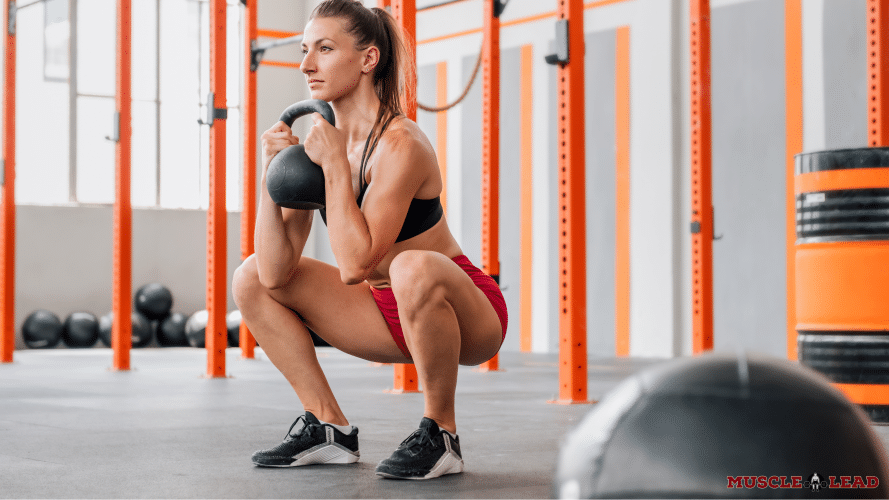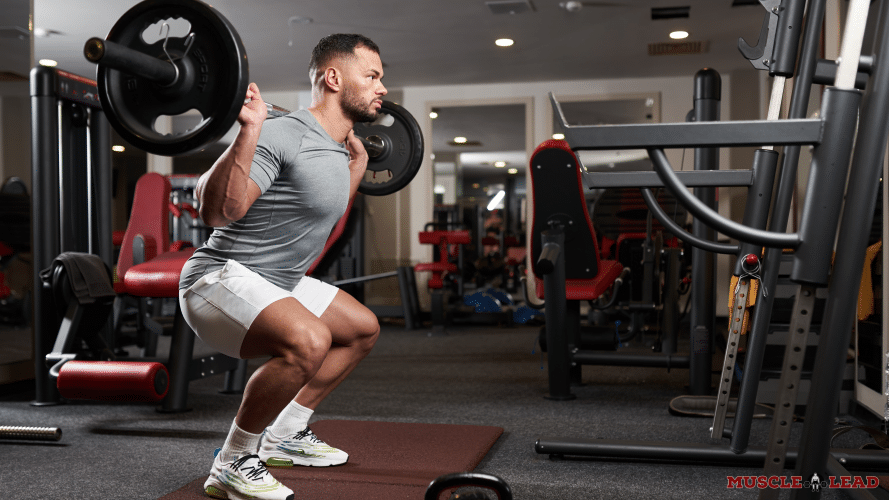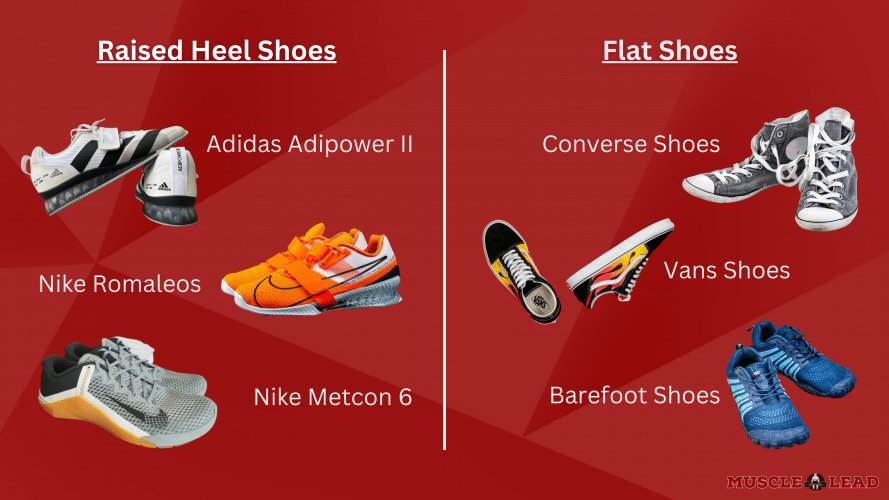‘Gym rats’ are always raving about what they think is the best footwear for weights room exercises like the barbell back squat.
A lot of lifters opt for flat shoes like converse and vans, but do not seem to know a lot about them, other than that they look cool and other buff ‘gym bros’ wear them to lift better.
I am not going to claim that flat shoes are the ‘best’ for squats, but they certainly have their unique benefits compared to other footwear with heel lifts.
So without further ado, in this article we will be discussing;
- ‘What Is A Flat Shoe?’
- ‘4 Reasons To Use Flat Shoes For The Squat’
- ‘Our Top 3 Choices for Flat Shoes’
What Are Flat Shoes for Squatting?
Without sounding comical, a flat shoe is a shoe that has flat 0-8mm soles. So, if you are a short guy or gal, do not expect to look any taller.
Jokes aside, what type of flat shoe would you want to choose for the barbell squat? Well generally, a shoe that is lightweight with a thin rubber outer sole. In fact, such a structure allows a lifter to press the feet against the ground with a degree of grip.

You might be asking why this is important? We have discussed this later in the article, so stay tuned to find out.
Learn more about Using Wrestling Shoes for Lifting
4 Reasons to Use Flat Shoes for Squats
A ‘gym goer’ once gave me a rhetorical question that went something on the lines of ‘what’s the big deal with footwear? I just want to squat’.
Well, there is a big deal with footwear, as it has the potential to change the whole dynamic of the lift.
In this section, we will discuss why you may opt to use some flats during the squat. We have highlighted their effect on;
- Ground Reaction Force
- Balance & Stability
- Squat Biomechanics
- Influence Others
1. Ground Reaction Force
While wearing the flat shoe, there is nothing between the foot and ground. In fact, this could allow a lifter to create a forceful leg drive from the feet without any obstructions. In turn, chaining into a strong and more energy efficient squat performance.
Imagine doing the squats off some cushions, a lot of energy would be absorbed resulting in a weaker squat. Not to mention, cushions are an unstable surface that causes poor balance.
Hence why I never recommend doing squats in running shoes. As a side note, running shoes have a spongy inner sole and heel lift/arch that caters for the shock and back/forth foot movements of running.
2. Balance & Stability
The outer soles of flat shoes that we choose for the squats are usually made of rubber and offer a degree of friction between the ground. As a matter of fact, this factor may keep a lifter balanced and stable, adding towards an efficient squat.
Some footwear does not grip well to the ground and may off put balance and lifting energy. For this reason, a lifter would probably not be able to hit those max squats or build as much muscle or strength in the longer term.
Furthermore, a loss of balance can risk a fall, followed by blunt force injuries like fractured bones, sprained joints and strained muscles.
3. Squat Biomechanics
Flat shoes force a lifter to use more ankle dorsiflexion (place weight on heels) to get into squat depth, which shifts the whole mechanics of the movement (1).
You would expect more forward torso lean and a more closed hip position, so basically your butt would be pushing further backwards (1).

Furthermore, this type of movement puts a lot of attention on the muscles of the posterior chain like the lower back, glutes, and calf muscles (1).
Over the longer term, the stretched ankle position of this movement may improve ankle flexibility and mobility.
4. Influences Others to Use Similar Shoes
One of the reasons you see so many gym goers wearing canvas shoes in the weights room is because they see other more advanced lifters doing the same.
Our job at muslcelead.com is to spread good gym information. If you have read and understood this article, try spreading the positive message by occasionally wearing flat shoes for the barbell squat and teaching fellow gym goers.
As Arnold Schwarzenegger says ‘rule #6 give something back’.
Read more about using Basketball Shoes for Lifting and Squatting
Flat Shoes Vs. Raised Heel Shoes For Squatting
There are 2 types of heel lifted shoes that are often used in the weights room setting, the running shoe and the wright lifting shoe.
The running shoe has a spongy sole and is not really designed for lifting, so I am going to write them out straight away.
On the other hand, weightlifting shoes offer some value from their unique structure.
Weightlifting shoes have solid inner soles and a rubber grippy outer sole (1). So just like flat shoes they help produce decent ground reaction forces and foot stability.

Here is where things get interesting. The weightlifting shoe has a raised heel, which puts the ankle into a pre-plantarflexed position.
This forces a deeper squat with a more upright torso position, placing more emphasis on the knee extensors (quadriceps) opposed to the posterior chain muscles (lower back, glutes, claves) like the flat shoe (1).
So to break it down, the flat shoe may be good for the lower back, glutes and calf muscles. Whereas, the heels shoe may be better for the quadriceps and upwards squat performance.
Our Top 3 Choices of Flat Shoes
1. Wrestling Boots
The wrestling boots is a stylish piece of footwear with flat soles.
Wrestling boots are lightweight and have a rubber outer sole.
It makes sense right? Wrestling also demands force productions from the legs and the ability to grip against the surface.
2. Barefoot Shoes
The Barefoot shoe is the most interesting looking footwear on our list, as it takes the shape of the foot.
The bottom layer of the shoe is rubber based like the other options offer some grip.
Barefoot shoes are a relatively new invention. Compared to the barefoot itself, it probably only offers more grip and some protection from foreign objects on the ground.
3. Plimsoll
I am sure many of you are familiar with vans and canvas shoes.
These shoes are cheap, casual, stylish, lightweight, and also have a flat rubber outer sole.
From my observation, these are the most commonly used flat shoes that we have observed in the gym.
Personally, if I had to choose between the 3, I would go for these, but obviously a Marvel print over Dark Comics **LOL**.
Final Thoughts
All in all, flat shoes have a flat inner sole and rubber grippy outer sole, which allow lifters to transfer forces through the feet and keep balanced during barbell back squats.
Furthermore, performing squats on flats recruits more of the posterior chain movement and muscles.
Last but not least, by simply wearing flat shoes during the barbell back squats you may influence others to do the same.
If you decide that flat shoes are worth the investment, you could choose wrestling boots, barefoot shoes, and canvas/vans.
Frequently Asked Questions
The unique properties of the flat-footed barbell back squat include;
More forward torso lean, more hip hinge, more dorsiflexion of the ankle, hits the glutes, lower back and calf muscles more. Flat shoes for squatting can develop ankle mobility and trains the posterior chain of movements for squats.
I would not say they are better, but different. The weightlifting shoes will hit the quads more, may be weightlifting specific, and possibly safer. The flat shoes may hit the posterior chain better.
Excellent! Less range to pull the bar up, great force production, and create a good stable base.
If you find that your glutes always take most of the work during the squat, then I would suggest wearing heel raised shoes like the weightlifting shoes.
The weightlifting shoes will keep the torso upright and demand more knee extension, thereby hitting the quadriceps
Then again, the way you squat is influenced a lot by limb and torso length.
References
- Sato, K., Forenbaugh, D., Haydock, D.S., et al. ‘Comparison of back squat kinematics between barefoot and shoe conditions’ International Journal of Sports Science & Coaching. 2013; 8(3): 571–578





